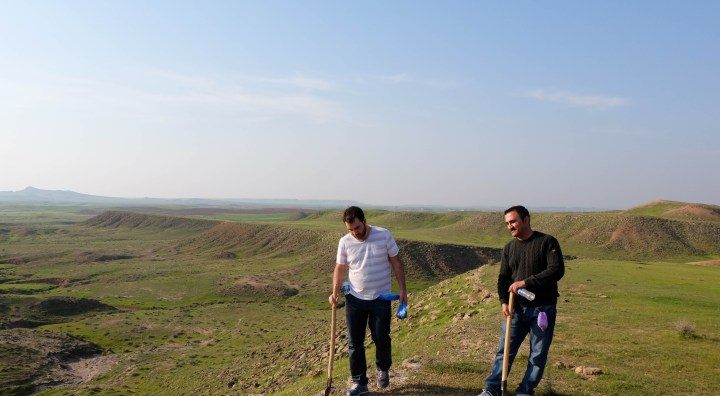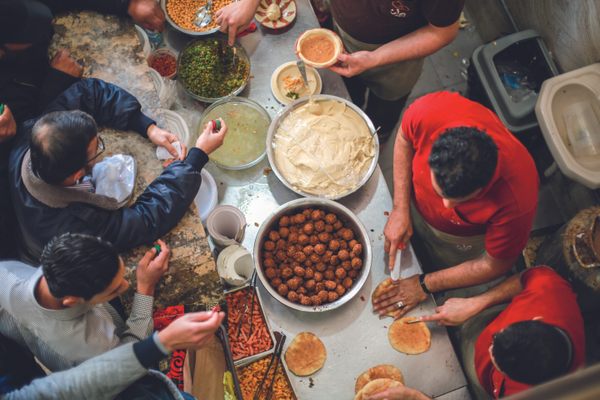The Perilous Art of Iraqi Truffle Hunting
With hidden landmines, looking for the fungi can be deadly.

Cousins Khogir (left) and Aram carry trowels, water bottles and a bag each of gathered truffles. (Photo: Campbell MacDiarmid)
This post originally appeared in Roads & Kingdoms. Find more food and travel storytelling at Roads & Kingdoms.
In the springtime, the arid lands of northern Iraq undergo a dramatic transformation. Winter rains have made the undulating landscape a verdant green. Between sandstone outcrops, farmers till unfenced fields of wheat and barley, and hillsides blossom with wildflowers. Hidden beneath the loam, a mysterious treasure blooms.
It’s early March, and a bath-warm breeze blows across the countryside east of Kirkuk, a multi-ethnic city of one million people in northern Iraq. Men roam the hillsides in a meandering fashion, strolling slowly and changing course often in response to unseen signals. They walk pensively, arms clasped behind their backs, holding narrow trowels or long screwdrivers. They contemplate the ground, studying its nuances. Hidden next to low shrubs, covered by grass clumps or nearly obscured by the impressions of goat hooves, they seek the faint mound and tell-tale crack that reveals a desert truffle pushing its way to the surface.
Cheaper and considerably more abundant than their distant European cousins, desert truffles are part of the genus Terfezia, found throughout the Middle East and Africa. They invoke a no less fervent passion among fanatical fungus foragers here than does the Tuber magnatum.
In Iraq, men have lost their lives in search of these truffles; others spend their lives in obsessive pursuit of them.
Retired Kurdish school teacher Ali Mohammed forages in the same area every year, near the village of Bawa, where his mother was born. This year, he’s brought his son Aram, an engineer in Kirkuk, and his nephew, Khogir, who works for a think tank in Erbil, the capital of Iraq’s autonomous Kurdish region. While the Kurdish Peshmerga fighters have shielded Kurdish regions from worst of the violence currently plaguing Iraq, a war against Islamic State militants is stretching toward its third summer, the economy is imploding, and tens of thousands of young Iraqis are leaving the country for Europe. Aram is looking for a way out, while Khogir is still on the fence. A day out truffle hunting provides a welcome distraction.

Retired school teacher Ali takes time out from truffle hunting for his lunch time prayer. (Photo: Campbell MacDiarmid)
Ali is an eagle-eyed hunter, completely fixated on unearthing the subterranean fungi. Aram and Khogir adopt a more leisurely approach, taking the time to elucidate on some of the finer points of truffle hunting. As we walk, they spin tales of successful expeditions, interweaving their anecdotes with snippets of local lore. Beyond their flavor—less pungent than the European variety—desert truffles are prized for their medicinal properties. A saying of the Prophet Mohammed suggests that when cooked as a soup, truffles make an effective remedy for ailments of the eye. Men also believe that eating truffles will enhance their potency and performance. “I don’t know, though,” says Khogir, a bachelor. “I’m not yet performing.”
As with their European counterparts, these truffles form a symbiotic relationship with the roots of specific plants and grow only in certain types of sandy soil under the right conditions. That makes cultivating them extremely difficult and predicting where they will grow in the wild more art than a science. Prize spots can be closely guarded secrets and hunters do not share all their techniques for finding truffles. Local legend holds that heavy thunder causes the spores to germinate, leading to expectations of poor harvests in years during which there are no lightning storms.
“Here, look.” Khogir plunges his trowel beneath a scarcely noticeable bulge in the ground. As he carefully lifts the mound upward, the soil cleaves apart to reveal a dark object the size of a small potato. Bowing our heads as if in prayer, we carefully wipe off the dirt to inspect it. It’s light but firm and has a slightly musty odor.
“Now we find his cousins,” says Khogir. Where one is found, others are likely to be discovered nearby.

Khogir carefully removes a truffle from the earth. (
“I have a friend who collected 17 kilograms”—nearly 40 pounds—“in a single day,” Aram says later. In comparison, the few truffles in the plastic bag hanging from his belt would weigh a few ounces at most. “I asked to go with him next time he went and he agreed, but when I told him I wanted to follow him, he said, ‘No way!’”
Across the landscape, small divots indicate where earlier foragers have already excavated their prizes. “We’re too late here,” says Khogir.
To find foraging spots that others have not can be dangerous in this region. A month before, two Kurds from the town of Kifry walked out past Kurdish peshmerga positions toward villages under the control of ISIS and went hunting for truffles in no-man’s land. The men were captured by ISIS militants and were later beheaded. Khogir relates this anecdote with a shrug, as if the self-evident allure of truffles explains the men’s motivations. In southern Iraq, truffle hunters risk death by foraging in areas that have been mined.

Truffle hunters stroll with their heads down, looking for the slight cracks which indicate a truffle. (Photo: Campbell MacDiarmid)
Back in Kirkuk, men rush down the street to inspect the first truffles of the season when they reach the market. They are sorted according to variety and size and sold mostly for consumption at home. The larger ones are selling for about 12,000 dinars a kilo this year (approximately $5 a pound), the small ones for less than 9,000. That’s cheaper than the European variety, but still a day’s wages for a manual laborer in Kirkuk. With oil prices low and the war against ISIS dragging on, the economy is severely depressed. “Nobody has any money right now,” says Khogir, and prices are lower than in previous years.
Talk of truffles long enough in Kirkuk, and your questions will eventually be directed toward Azad Khanaqa. Dr. Azad, as he is known locally, is undoubtedly Kirkuk’s most illustrious truffle hunter, whose childhood memories of searching for truffles on his father’s estates started him on a decades-long journey to solve the mystery of what makes them grow.
Azad lives in Ireland now but comes from a prominent local family. I am soon in touch with Goran, the husband of one of Azad’s nieces. Family commitments prevent Goran from getting out truffle hunting much these days, but he finds time to take me on a tour of the rolling farmland on which Azad grew up. Goran is still a dedicated truffle consumer, he tells me, buying up to 50 pounds at a time when they hit the markets and storing them in his freezer.
He also has an ample supply of truffle trivia and opinions. The black truffles are better than the white variety, he says. “Kurdish land makes black domalan,” he says, using the Kurdish word for truffles. “White is Arab domalan,” and, he adds, no good.

A man sells truffles in Kirkuk. This year a kilo of smaller truffles like these sells for IQD9,000. (So a pound sells for about $4). (Photo: Campbell MacDiarmid)
Later, I reach Azad via Viber. At a young age, Azad became transfixed by the mysteries of how truffles grow. So he studied agriculture in Baghdad and later in Germany, continuing his research at the University of Göttingen. His studies confirmed the folkloric belief in a correlation between the winter storms and truffle production: The rains hatch the seeds of certain plants with which truffles form a symbiotic relationship, their spores living in their root systems. The lightning from those storms fixes nitrogen in the soil, encouraging the truffles to thrive. But replicating this process proved nearly impossible.
By the time he finished his doctorate, he still hadn’t found a way to cultivate truffles and in 1980 returned to Baghdad. There he worked for the government researching mushrooms and, of course, truffles. The Iran-Iraq War was ongoing and as casualties mounted, President Saddam Hussein introduced conscription. “I said that’s crazy, after studying for so long, to go to war, for what?”
So Azad returned to Germany to continue looking for a culture that would germinate truffle spores in the laboratory. After eight years at Hanover University, he had exhausted his funding and was still no closer to success. “The university professor told me, ‘Nobody can do it,’” he recalls. “I prayed for myself.”
He continued his research, paying his own way this time. And then, in 1994, after trying and failing with more than 10,000 petri dish cultures, he had a breakthrough. Spores on a dish germinated and he was able to successfully introduce them onto the root stock of plants in a nursery. Amid a flurry of media attention, big offers rolled in from across the world to buy trees with roots infected with truffle spores. A research institute was named after him at Hanover, and a lucrative contract to grow truffles for Prince Khaled bin Sultan in Saudi Arabia followed.
Today, Azad has truffières—truffle orchards—across Europe. But so far, he has not been successful in growing them in Iraq. Between the instability and the political climate—he’s a staunch critic of the Kurdistan Regional Government—he doesn’t spend much time in Iraq these days and has to rely on local partners. However, these intermediaries have been skeptical that the upfront investment and lengthy cultivation period before the inoculated trees start producing truffles are worthwhile.
One attempt ended in disaster after a business partner tore up 5,000 of his truffle-infected plants. “He said, ‘How can I wait three years?’ and he took out the plants which I had brought from Cyprus and grew cucumber and tomatoes.” Azad recently brought in another batch of inoculated seedlings, but it will be at least three years before they start producing.

Khogir’s truffles at the end of a day’s foraging. (Photo: Campbell MacDiarmid)
Following our foraging expedition, there remains the preparation of the truffles, which leads to debate. Azad suggests simply frying in oil. Khogir and Goran insist on boiling the truffles first. Barbecuing on skewers is apparently also suitable. All agree that the grit must be carefully scraped from the delicate skin. Khogir oversees the preparation of our meager haul, taking meticulous care to remove every grain of sand. The cooking water produces an earthy liquor that is reserved as a soup while the thinly sliced flesh is fried with raisins and served on rice. The taste is similar to mushrooms, with a firmer flesh the consistency of artichoke hearts. The resulting meal is enjoyable, if somewhat underwhelming considering the effort.
But perhaps the real allure is the act of gathering the truffles. Kurds were once largely nomadic people, and great foragers. Elsewhere in the Middle East, bedouins are also renowned truffle hunters. In Iraqi Kurdistan, people eagerly await the changing of the seasons for the new produce it will bring: the first fresh almonds or pomegranates, waterside greens gathered during a picnic, wild rhubarb picked on a mountain hike, or a bunch of sour sumac berries pulled from a bush on the side of the road. The gathering of wild food is the continuation of a timeless tradition.
As we slurp up the last of the soup and scrape the pan out with bread, we are already planning our next expedition.

Gastro Obscura covers the world’s most wondrous food and drink.
Sign up for our regular newsletter.
























Follow us on Twitter to get the latest on the world's hidden wonders.
Like us on Facebook to get the latest on the world's hidden wonders.
Follow us on Twitter Like us on Facebook